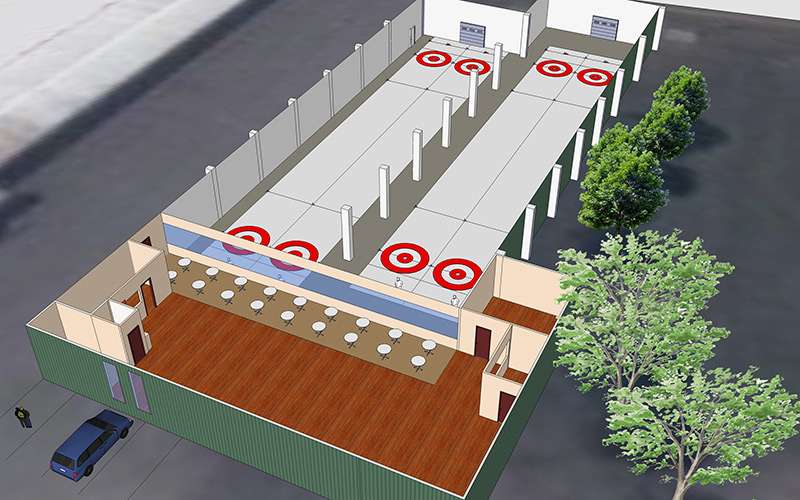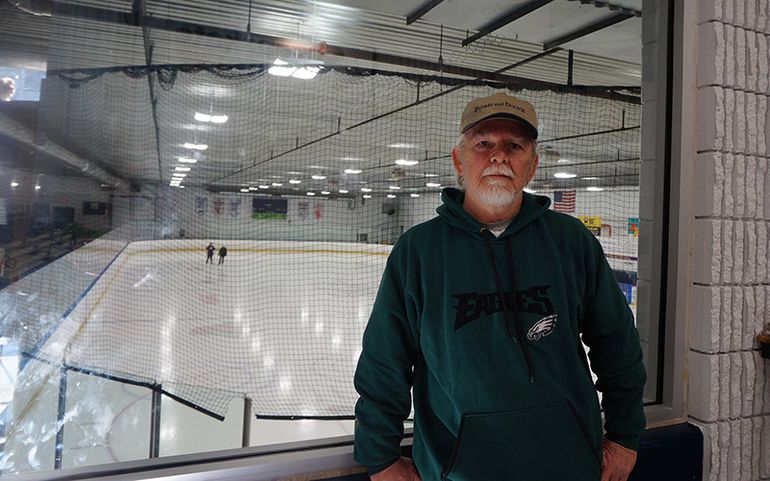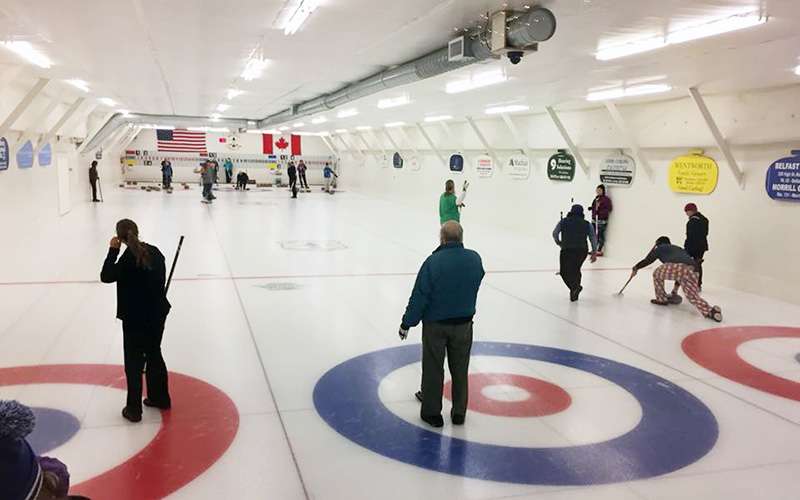
Portland curling club seeks home of its own in tight real estate market
 Photo / Maureen Milliken
David Florig, a member of the Pine Tree Curling Club Board of Directors, at the William B. Troubh Ice Arena in Portland, where the club meets on Wednesday nights. The club hopes to construct a curling center, or find a building that can be turned into one.
Photo / Maureen Milliken
David Florig, a member of the Pine Tree Curling Club Board of Directors, at the William B. Troubh Ice Arena in Portland, where the club meets on Wednesday nights. The club hopes to construct a curling center, or find a building that can be turned into one.
A figure skater glides onto the ice at Portland’s William B. Troubh Ice Arena. The ice looks smooth and slick and inviting.
But David Florig, watching from above, sees all the work involved that is necessary to change the surface from something that’s great for hockey and figure skating, but not for curling.
“Most people think ice is ice,” he said. “It’s not.”
The Pine Tree Curling Club, which formed in 2015, is doing well — its Winter League began last week and it has more than 50 members of all ages, genders and abilities. It’s got plans for a Learn to Curl event in March that it hopes will draw more than 200 people interested in the sport.
The club owns its own equipment, including 80 stones, the 44-pound round piece of granite that’s hurled down the ice.
There’s just one thing in the way of the club expanding the way it wants to — a home of its own, something that might be tough to find in Portland’s tight industrial and warehouse real estate market.
The board of directors is just beginning to look, but hopes to find a 17,000-to-20,000-square-foot building, or property to build one, in the greater Portland area.
“It’s been a dream [of the club] for a while,” Florig said.
The club meets at 9:30 p.m. on Wednesdays at the arena on Congress Street, and the time available and size of the ice limit how many members can complete.
The club doesn’t host bonspiels — the multi-club competitions that are the lifeblood of curling — because they are weekend-long events that include as much socializing as curling.
Florig said “a dream” would be to have four sheets — the 150-foot-long by 15-foot-wide specially treated ice that a curling match is played on.
They’d settle for less, though, to have their own place, allowing the club to grow.
'You want them to come back'

A curling center “would look a lot like this, without bleachers,” Florig said as he stood in the lobby above the ice at the Troubh recently.
It would have the ice house — the part where the sheets are and the games are played; a warm room — the place where the beer is; glass separating spectators from the ice, and some office and changing space.
The city-owned arena has been a good partner to the club, but there is a lot of demand for ice time.
Another major issue is that the ice for skating and hockey is a lot different from the surface needed for curling, and it takes a lot of work to get it right.
The surface is scraped smooth and then “pebbled” with a fine spray of water to allow the stones to move down the ice. Hacks — toeholds — have to be gouged into the ice as well.
Dedicated curling sheets are a requirement for hosting a bonspiel, and a club would ideally host four or more a year.
“Bonspiels are important for sustaining a club,” Florig said.
“They’re generally two or three days, and renting a facility for that long would be prohibitive,” he said. “And the ice wouldn’t be what people expect. You want them to come back.”
Bonspiels bring people from around the region or across the country into the area for days at a time.
“They eat, drink, stay at local hotels,” Florig said. “Portland is perfect for it.”
According to Mark Inglis, a York, Ontario, an urban designer who blogs at yorkurbanist.com and designs curling facilities, a three-day bonspiel can generate $53,000 in Canadian dollars for a community. That would be about $40,000 in U.S. dollars with the current exchange rate.
While the Pine Tree Club is in the initial stages of its search, members have already visited curling arenas in the region to check them out, including Maine’s only dedicated curling center and only other club, on Route 3 in Belfast.
“We’re finding out what their wants are, versus what their needs are,” Florig said.
The Belfast Curling Club has been around since 1959, when its first building was constructed on a site where curlers had flooded the field and played outdoors. That building was replaced in 1962 with a three-sheet clubhouse and a dance hall was added in 1977. The 13,000-square-foot building underwent extensive renovations in 1991. The club also rents the building out for events.
Before the Belfast curling center was built, members did what Pine Tree Club members are doing 60 years later — they played at ice arenas where they could, and often traveled to places like St. Stephen, New Brunswick, to use a dedicated curling facility.
In 1959, friends from the St. Stephen club, volunteer masons, carpenters, plumbers, electricians and laborers built the Belfast club, according to its website.
The land, a former gravel pit, was donated and volunteers made 5,000 cinder blocks for the structure.
Tough, tight market

In 2019, finding a building for a dedicated curling center, or finding the money to build one, will be a little more difficult.
The club is in the early stages, and hasn’t yet determined if they would build a center, which Florig said could cost as much as $2 million, or find one to to buy or lease, and retrofit it for curling.
“The decision will ultimately be an economic one,” he said.
Justin Lamontagne, a broker with NAI The Dunham Group, said that the industrial inventory in Southern Maine remains historically tight.
“A lot of non-traditional users like sports clubs are forced to consider alternatives,” he said.
Two recent examples of warehouse and retail space being repurposed for recreational use are the Urban Trampoline Center, which located in Shops at Clark Pond in South Portland and Get Air, another trampoline center, which is in former warehouse space on Riverside Street in Portland.
Lamontagne, who was speaking generally and is not involved in the Pine Tree Club’s search, said that nationally, and locally, big-box stores are being converted to non-traditional sports-focused facilities, including indoor bounce centers like the Urban Air Trampoline Center, which opened recently at .
He said that local zoning can be restrictive when it comes to repurposing space, which means municipal cooperation is often needed.
He added that parking in traditional warehouse spaces often isn’t enough to support higher-impact uses.
“Warehouses are typically built with a two-parking space per 1,000-square-foot of building space, where a recreational facility would need far more that,” he said. He estimated recreational space could need as many as eight spaces per thousand.
Also, with a competitive market, landlords are in a position to be selective.
“Given the choice between a traditional industrial tenant versus a higher impact use with traffic, families, redevelopment costs, etc., the choice is rather easy to go with a less impactful business,” he said.
Inglis, the Ontario urban planner, does consulting on curling facility design and has had discussions with U.S. clubs that want to go from arena rental ice to dedicated facilities.
“Accomplishing that requires a business minded group,” he said. “The ice shed and associated lounge costs vary with the size of the facility.
We provide business planning for groups, as well as architectural design. The business and architectural plans are inherently linked. Most business plans show the greatest revenues 'behind the glass' (in the lounge).”
Building strong local connections

Florig said that the Pine Tree Club discussions are in the very early stages.
“We don’t expect anything for free,” he stressed. “We are figuring out ways to make this work.”
The club, which is a 501c3 nonprofit, has made strong local connections in its short history.
The Maine Brew Bus stops at the club’s Wednesday night league and those on the tour learn to curl before they hit the breweries.
The club also works with the Alzheimer’s Association on programs.
Curling, which began in Scotland in the 16th century is, by its nature, an inclusive and social sport. The club would add as many leagues as possible with its own facility, including youth leagues, wheelchair leagues, senior leagues and more.
“We’d have as many leagues as we could hold,” Florig said.
It would invite local colleges to use it — Bowdoin, one of the few college clubs in the state practices at the college’s Brunswick ice arena and travels to Belfast for bonspiels.
The Belfast Club has more than 100 members, not only from the Mid-coast, but stretching inland to western Maine, down to Portland and up through Penobscot county.
Florig said the Portland club doesn’t want to encroach on Belfast’s territory, and the center would have to be somewhere in the city or in a nearby community.
He said he’s sure there’s enough interest to make a dedicated curling center sustainable in the area.
Curling has traditionally been popular in Canada, but interest in the U.S. has grown since it became a medal sport in the Olympics in 1998.
“U.S. curling is in a growth phase,” Inglis said. He said the U.S. gold medal last year has given it a boost. “But the sport was already growing due to curling becoming a medal sport in 1998 … Similarly, Asia has exploded with construction of dedicated facilities in Japan, Korea and China.
There are 113 dedicated curling centers in the U.S., and 311 clubs, according to USA Curling.
Nearly half of the dedicated centers — 52 — are in Wisconsin and Minnesota. The rest of the clubs either play in arenas and 23 are “paper clubs” that don’t have a place to play.
Like many of the Pine Tree Club’s members, Florig has only been playing for a few years. While a lot of skill is involved in making the stone go where it’s supposed to, it’s not so physically taxing that it limits who can compete.
That, and the social aspect, are a big part of its appeal.
“It’s a gentle-person’s sport,” he said. “Players referee their own matches, the winning team buys a round for the losing team.
“It’s just great for the community, in a lot of ways,” he said.










Comments